Ms Marvel #1 (Marvel, $3.99)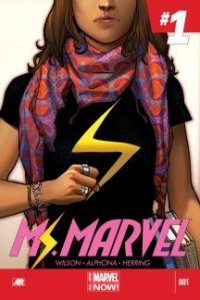
By Jeb D.
Given that the new Ms Marvel isn’t Marvel’s first Islamic superheroine, the publicity blitz surrounding this debut is about the fact that she’s the first such character given her own ongoing series. I’m not sure that distinction means all that much, really: the Big 2 (and, more to the point, their audiences) don’t have strong track records for supporting female-centric books (even Wonder Woman needs regular reboots to jumpstart sales), so it wouldn’t be surprising to see this turn out to be little more than a blip, commercially speaking, on the Marvel publication schedule. That would be a shame, because apart from its potential longevity, or lack of same, Ms Marvel needs to be considered on its quality as a comic, and on that basis, it’s a worthy addition to the Marvel stable of female-centric ongoings (including Captain Marvel and the upcoming new She-Hulk series).
Ms Marvel #1 is pretty much a classic Marvel Comics’ origin story: Kamala Khan is a teenager who feels alienated from both family and the outside world, and undergoes a transformation that will serve as both wish-fulfillment and burden (Stan Lee may claim not to really know where his famous “power and responsibility” phrase came from, but if that’s true, then his subconscious created the template for the Marvel Comics empire).
What makes this an interesting riff on that standard introduction, of course, is the very specific form of Kamala’s alienation: she’s not nerdly science geek Peter Parker, she’s a second-generation Islamic immigrant teenager, equally uncomfortable with the cultural restrictions placed upon her by family heritage, with the more liberal teenage environment in which she operates, and with the inevitable clash of the two. Writer G. Willow Wilson understands that she’s got to cram a lot into the debut issue, so the pacing is very 60’s-Marvel style, with introductions brisk, but well-characterized; at times she’s running the Bend It Like Beckham playbook with the scenes of culture clash, but she does an excellent job of sketching the different challenges that the immigrant experience poses for the respective members of Kamala’s family.
Given that this is a superhero comic, though, it’s unsurprising that Kamala’s brand of geekiness comes in the form of Avengers fandom, and Carol Danvers’ specifically (though Kamala favors the “classic politically incorrect costume” and wants to “kick butt in wedge heels”). It’s a meta-textual concept that requires some tricky balancing not to feel forced or gimmicky, but given that Kamala’s alienation takes the form of being a circumscribed, dark-complected Muslim in a blonde world of party-hardy teens, it’s a sign of her assimilation difficulties that she would dream of the glamorous version of Carol Danvers, with the flowing gold tresses and scandalously revealing cutaways.
One barrier for new readers may be the fact that Kamala’s transformation comes as part of the Inhumanity event. For those not following Marvel closely, their film division has been somewhat hampered by contracts drawn up during the 80’s, when the company was in desperate straits (and, evidently, collectively drunk), ceding the whole concept of “mutants” to another film studio. It was recently decided in the comics to essentially replace mutants with “inhumans,” as a means of getting around this. Now, instead of potential Inhumans having to visit the Terrigen mists for their transformation, the mists are coming to the potentials; as a result, the last third of the book, where Kamala undergoes this metamorphosis, and everyone around her is surrounded by blue fog, is going to feel rather out of left-field to a lot of readers.
I don’t know if it’s the compressed nature of the first issue, or the familiar presence of artist Adrian Alphona, but some of the teen-life details feel a bit stale; the speech patterns that Willow gives the teens in the book pretty much sound just like the Runaways of ten years’ ago. Still, I’ll gladly put up with some last-decade slang for the pleasure of seeing Alphona’s art here. It’s not simply that he’s told tales of superpowered teens before: the members of Kamala’s family are all clearly distinguished and well-realized (and doing so with characters of color is not always a strong point in American comics), the background detail is always vivid in the essentials, but never fussy or overpowering, his facial expressions drive home the best lines, and his depiction of the transformational phantasmagoria that Kamala experiences is vivid, with a nice cultural specificity to it.
Alphona also nails the thought-provoking final page: when Carol Danvers’ dream-self warns Kamala of the “be careful what you wish for” consequences of having her aspirations realized, I doubt that many readers were expecting a result that seems to up the ante on the book’s consideration of cultural issues. I won’t spoil it, but let’s just say that the various promo images we’ve seen of the new Ms Marvel have kept hidden what should have been an obvious (and, I’d assume, temporary) phase in the desire of a teenage Muslim girl who wants to break away and assimilate into the majority American culture.
As I say, it’s tempting to consider the new Ms Marvel in the context of its commercial prospects, and what it means in terms of diversity and inclusiveness in today’s comic marketplace, and I won’t disagree that those considerations carry some weight. But I’d rather recommend it on the basis of it being first and foremost a well-told superhero origin story that, while invoking the classic comics of the mid-20th century, may also have something worthwhile to say about the culture wars of the 21st.
Rating: 




Out of a Possible 5 Stars
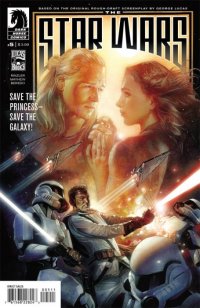 THE STAR WARS #5 (Dark Horse $3.99):
THE STAR WARS #5 (Dark Horse $3.99): By Cat Taylor
One could be forgiven for avoiding The Star Wars up to this point. Other than the rock band, Kiss, there has been no bigger whore of merchandising tie-ins than Star Wars. So, it’s understandable why anyone would think another Star Wars comic book series wouldn’t be worth the time or money. Even I, as one of the world’s biggest Star Wars geeks, am jaded about all the tie-ins and expanded universe material. However, I am glad that I went with my curiosity for the intriguing premise of a limited comic book series based on George Lucas’s original drafts. It has been a fun and interesting read so far and the latest issue might be the best one yet.
One of the more fun things to do with this series is spotting the nods to the final movie version. In this issue, there is a scene that no doubt served as the inspiration for the scene in The Empire Strikes Back where Lando leads Han and crew to the dining room occupied by Darth Vader, but the majority of this issue plays closest to the Death Star rescue and escape in Star Wars: A New Hope. The escape in the original draft is quicker and more violent than the final movie version. It also involves using electricity to break out of metal handcuffs, which according to my college education should have electrocuted the prisoners wearing them but I guess it’s some kind of insulated space metal or something (where’s my No-Prize, Stan?). Opinions will vary as to whether the originally drafted versions of certain scenes are superior to what ended up in the final movies, but there is one scene in this issue that I can’t believe anyone would think is anything short of embarrassing. I’m referring to the scene where Leia declares her love for Annakin and where Annakin realizes he loves her. The situation is so forced and comes off as so unnatural that I wonder if George Lucas had ever even been on a date when he wrote it.
As far as the artwork is concerned, Mike Mayhew’s style fits the pulpy tone of the story, with a logo, settings, and character designs that are consistent with this version of the Star Wars universe. Finally, if I haven’t complemented the artist enough, he does an amazing job with creating characters with distinct and realistic appearances. It doesn’t take much imagination to visualize what these characters would have looked like as actual actors in a movie.
If you haven’t been reading The Star Wars up until now, I suggest either finding some cheap back issues or waiting for the trade because this is a fun but continuing cohesive story. This original draft, as translated into this story, feels more like the pulpy inspiration of Flash Gordon and Buck Rogers than the ultimately resulting movie. While the comic book translation proves that the original draft is good in its own right, one thing that really stands out is that there are about double the number of main characters than ended up in the movie. I can see how difficult and confusing it would have been for a young child to wrap his or her head around that many characters. As a comic book mini-series, on the other hand, it works.
Rating: 




Out of a Possible 5 Stars
Loki: Agent Of Asgard #1 (Marvel Comics, $2.99)
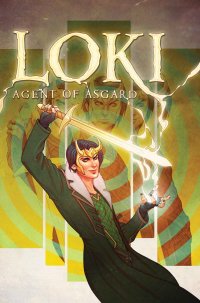
By Devon Sanders
What doesn’t this book have?
…..???
One issue in and I’m pretty damned hooked.
Largely due to Tom Hiddleston’s portrayal in the Thor/Avengers franchises, Marvel Comics wisely takes advantage of Loki’s recent fan favorite status and ages him up from a deceitful boy trickster and former Young Avenger to a lanky, deceitful post-teen trickster in the employ of his the realm of Asgard.
Loki: Agent of Asgard #1 hits all the right notes for however fans came to the character. For the ladies and gents who like a little Hiddleston in their Loki, the comic opens with a naked fan-fic ready (You know who you are) Loki in the shower, singing. The mood is quickly broken up quite beautifully by… well, it’s worth seeing with your own eyes. For the ladies and gentlemen who prefer their Loki fighting and tricking Avengers, one of whom happens to be Thor; man, do writer Al Ewing (Mighty Avengers) and artist Lee Garbett (Batman) ever come through for you.
Ewing gives us an interesting mechanism for redemption and hi-jinks in this series. Loki: Agent of Asgard very much is what the title suggests in that it is, in one issue, shaping up to become one of the best espionage comics I’ve read in a while. The premise is a brilliant one and full of promises for mayhem, familiar and familial. Ewing’s Loki is a true charmer, drawing you immediately into Loki’s struggle for balance between outright mischief and downright evil. Artist Lee Garbett ably illustrates it all in a manner well-suited for comic that uses moments of quiet amongst the hectic kineticism established in Ewing’s excellent script.
Loki: Agent of Asgard #1 is another true gem from Marvel. Loki finds a way to be everything you want out of the character while far exceeding those expectations.
Rating: 




Out of a Possible 5 Stars
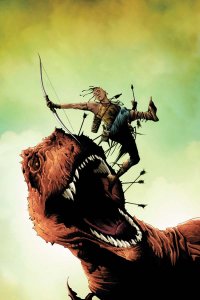 Turok: Dinosaur Hunter #1 ($3.99, Dynamite)
Turok: Dinosaur Hunter #1 ($3.99, Dynamite)
by D.S. Randlett (@dsrandlett)
Turok’s always been a tough character to really nail down beyond the basic concept of “badass Native American survives in a land of Dinosaurs.” It really is a sixties TV pitch: designed to keep the same mood and concept going for as long as sales or ratings can sustain it. Much like other characters of the era, Turok first appeared fully formed, and he never really changed. It was a different time for genre fiction, when there were no long arcs for either stories or protagonists. Characters like Captain Kirk could swing from adventure to adventure and never really change, and Turok fit that model. But unlike the best of classic Star Trek, Turok stories were rarely all too different from one another. The concept didn’t really lend itself to that. There was only so much you could do with the wilderness of the Lost Land besides introduce a new Dinosaur every month. The old Turok series wasn’t without its charms. It managed to leverage its limitations into the perfect young boys’ romantic adventures. Of course, I mean romantic in the eighteenth century sense. It was at once the survival romance of Robinson Crusoe, the romance of the discovery of alien creatures (which is what the lifeforms of previous eras often seem like), and finally, and somewhat troublingly, the romance that comes with white postcolonial people imagining existence as a noble savage.
After a good long while, Valiant Comics, which had been rebooting other fondly remembered Gold Key characters like Magnus, brought Turok to my attention when I was about nine or ten years old. I fell in love with the character almost immediately. Part of it was just the basic imagery of Turok taking on hordes of dinosaurs with nothing but a bow and arrow on the iconic-ish Bart Sears cover of the first issue. The first three or so issues, which were basically all about Turok getting adjusted to the modern world after being ejected from the Lost Land, were alright in my young estimation. It wasn’t until Tim Truman took the title over that Turok really clicked for me. Where the first arc on the title was very nineties, with an emphasis on revenge, Truman’s run folded the things that had worked about the original sixties version of the character into a more modern milieu. There were some twists to the old formula, sure, but for the most part they served to bring out what had always been the core of the character: above all things, Turok is a survivor.
Truman’s run also did some interesting things to flip the script on the romance of the sixties version of Turok. Turok was still in a lost land, but that land was the modern world, where he could lend an outsider’s perspective. Most telling of all was Turok’s relationship to the white people who populated the series. He was paired with a blonde anthropologist most of the time, and she often represented a sort of patronizing White Guilt that viewed Turok as a precious example of the past, something that must not be harmed. This made for some interesting drama, as Turok very often just wanted to live his life and do the right thing, which often involved putting himself in danger. Many of the villains also represented a darker streak to white culture. You had poachers, time lost pirates, and wealthy connoisseurs who collected endangered species (this, naturally, included Turok), and in most of these portrayed in broad, genre strokes the evils of post colonial white entitlement. Truman (and it must be said, the great Rags Morales) used his run on Turok as an outlet for not only high octane action adventure stories, but he wrapped them around a foundation of an examination of the present’s relationship to the past and the sins of European colonial culture. But it, ultimately, still a white man’s perspective. Still, as a white kid reading this in the nineties, growing up in Virginia at a time when it seemed as if white privilege was at a fever pitch in local political discourse, Turok ended up becoming a space where I could simply feel free to admire and empathize with a man who was not white away from the chatter of the right wing radio that the adults in my life seemed addicted to. I will never forget that, and it is one of the reasons why I’ve long awaited the character’s return.
And so he has, this time at the behest of Dynamite Comics (now the standard bearers for the Gold Key line) and writer Greg Pak and artist Mirko Colak. Leading up to the release of the new Turok, I had been reading interviews with Pak, and was intrigued by some of his statements about how he was excited to write for one of the few major characters in heroic fiction who was not a white man. Coming from Pak, who, like his subject here, is not white, got me really curious as to how that perspective would play out. The answer is simple: the character of Turok plays out like a, well, character. That’s it. So what do Pak and Colak do with that?
Pak’s script eschews both the classic and the Truman approaches to . There is no Lost Land, or misadventures in the modern day. Instead, Turok is in his element: a Native American among Native Americans. Except he is in something like exile, as his parents were, apparently, murderers (just one of the many plots that this first issue sets up). And so Turok, an young adult at this point, lives on the fringes of his tribe as an outsider, surviving by seeing to his own needs. He has a mantra that he tells himself, “Alone is better,” paralleling certain 18th and 19th century romantics. You can tell that he has a hard time maintaining his belief in that, even though the actions of his pseudo-tribesmen sometimes make that not so difficult. Some events transpire later on in the issue that put Turok into an interesting place. I won’t say who shows up (it’s not just dinosaurs), but it invites another interesting take on the damages done by colonialism, and it essentially makes Turok an outsider and an insider at once within the narrative. Pak’s story works seamlessly as a straight adventure narrative, but the political subtext is valuable and needed. Where Truman’s Turok gave expression to White Guilt, Pak’s Turok looks like it might give at least some expression to the historic grievances of the cultures steamrolled by Europe in the colonial period. More amazingly, Pak, sets this up without ever being preachy, and without ever romanticizing certain stereotypes. He simply presents a well drawn character and invites you to empathize with his trial, and that’s enough to drive home the point. It’s a case study in why diversity in storytelling is a good thing.
Mirko Colak’s art is very solid. He excels at presenting the natural world that Turok inhabits. The woods are thick and detailed, throwing intimidating shadows over characters as they’re chasing Turok down to make him pay for his parents’ crimes in scenes that are almost noirish. Of course, once the adventure elements kick in and it’s time to run from some dinos, Colak clears the scene up to give you a good look. There are some hiccups. Some of the action panels later in the issue feel like they lack weight compared to some of the amazing pages earlier in the book, and the first reveal of the dinosaurs isn’t as effective as it maybe should be. Some of this is down to Pak’s script, too, as the (feathered!) dinosaurs just kind of show up. While I bought the shock of the characters, I never really shared it due to the lack of prior tension leading to their reveal.
It’s not perfect, but the new Turok is a fascinating entry into the history of a compelling character within the genre canon. Highly recommended.
Rating: 




Out of a Possible 5 Stars
All-New Marvel Now! Point One One-Shot (Marvel, $5.99)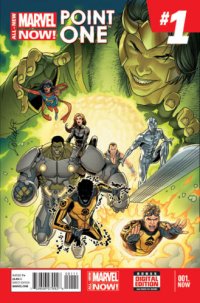
By Adam X. Smith
So this is where it all kicks off for Marvel’s much touted but so far mildly underwhelming All-New Marvel Now! line of books, so called because as of this writing I’ve only succeeded in reading one of them that was actually a brand new series and not just an old one with a big fat red and white #1 on the front. That being said, Point One does give us discerning comic readers a sampling of what we can expect from the flagship titles once things start getting underway later in the spring. Sort of a “try before you buy” tactic that I remember from those heady days when DC’s Infinite Crisis was still a recent memory and after reading their Brave New World sampler I got suckered into reading Uncle Sam and The Freedom Fighters and The Creeper. Sigh.
So here we go, in no particular order. The re-view, the re-view, whut-whut, the re-view.
Back in my review of Black Widow #1 I said it reminded me of a pilot episode. That being true, “Predator”, the story that Nathan Edmondson and Phil Noto bring to the table, feels a little like a Youtube mini-prequel in terms of scope, but continues to coast on its excellent artwork. Look, you know and I know people are gonna buy this series, so small potatoes aside, it’s a fun little 8-pager of Natasha wrong-footing Russian douchebags and some pretty cool artwork.
The Avengers get some new recruits in the form of Sunspot and Cannonball (umm, aren’t they supposed to be X-Men?) in a neat but largely forgettable story from Nick Spencer and Rags Morales. Reading it didn’t annoy me but it didn’t exactly wow me either. Avengers and SHIELD working together, blah blah blah, Maria Hill being cute with Captain America, blah blah blah, AIM stealing a secret formula that turns people into the Hulk for a bit, blah blah. For this reason, “Short Term Fixes” comes in second-to-last place for the Least Likely to Get Picked Up by Adam Award, trailing only slightly behind…
What to say about All-New Invaders’ “To Tame the Very Gods Themselves” without being mean for the sake of it. Ummm… the art’s… okay, I guess? Ugh, look, I know every annual or special has a duff portion, and this one is no exception, but with a title like that you expect a little more. Instead what we get is sort of the boring middle child that only knows how to spout exposition in faux-grandiose tones (from a glowing green giant alien head, no less) and picks the three characters I give the least fucks about to make its protagonists – The Human Torch (not the one you’re thinking of), Namor the Submariner and Bucky Barnes, who at some point has been made over to look like Michael Biehn and is shown in the final panel with a gun that would make Cable feel inadequate. The plot, from what I can decipher is something about the Kree wanting to reclaim a mystical MacGuffin that the previously mentioned heroes hid in WWII and how they intend to do that is through finding and mind-controlling them (possibly, the writing is very poor) so they can control the universe. Seriously, fuck this storyline. I’m getting narcolepsy just writing it down.
“So what is worth reading in all this?” I hear you ask. Well, little voice in my head, let’s start with G. Willow Wilson and Adrian Alphona’s Ms. Marvel short “Garden State of Mind” which introduces Carol Danvers’ successor and fangirl, Kamala Khan, as an Asian-American Jersey girl struggling to fulfill her family commitments by day and a butt-kicking superhero by… well, also day. Alphona’s artwork gives us a brilliant earthy contrast with the rest of the stories, and really sells Kamala’s shape-shifting abilities without ever making her feel like a distaff Plastic Man.
Likewise, from Dan Slott and Mike Allred, we get “Girl on Board”, a taster of what’s to come from the newly returning Silver Surfer, and it all seems a bit Doctor Who-esque: mysterious hero with distinctive transportation and female companion – check; surreal cosmic backpacking trip with a considerable amount of danger and action – check; fabulous environments full of weird and interesting aliens – check; lack of clear narrative direction but with the promise of more visually striking episodes to come – big check.
And finally, from Al Ewing and Lee Garbett we get the glue that holds these disparate stories together – “Before The Truth Has Its Pants On”, a series of one to two-page stories acting as a framing narrative to Point One’s over stories as well as a lead-in prologue to Loki: Agent of Asgard, in which “Odin’s other son” goes on a quest that takes him from an intergalactic gambling den to the Red Skull’s private mancave to a familiar holding cell aboard a SHIELD hellicarrier to the Braddock Academy in Goode Olde Blighty (complete with ridiculous fake Cockney accents and British bobbies cor-blimey guv’nor)* to an encounter with his brother and rival Thor, all to locate five keys forged by Odin for when he proves himself worthy (or, as he states, “learns to fake it”) that give him possession of Gram, the sword of Sigurd, first of the Asgardian heroes.
Now, whether or not you’re a fan of Loki as a character, (and chances are good that you will be, based on the success of Tom Hiddleston’s iteration,) Marvel is not stupid. They’re well aware that Loki sells the Asgardian brand as well as (if not better than) Thor, his trickster status makes him handy as an unreliable narrator and villain-protagonist, and his backstory and connections within the Marvel universe provides the possibility of comedy without having to have every interaction revolve around toilet humour ala Deadpool. And while Garbett’s art lacks the visual flair of some of the work surrounding it, it never falls flat and the set-up suggests a storyline with some intriguing twists and turns.
So that’s All-New Marvel Now! Point One in a nutshell – a nice little sampler that will save you some time and money later on in the year when things really get cooking. Sure, you could expect more, but that probably means there’s no pleasing you anyway.
Rating: 




Out of a Possible 5 Stars
*Am I the only one that’s disappointed that of all the dozens of titles that are being brought back, Captain Britain isn’t one of them? Sort it out, Marvel.
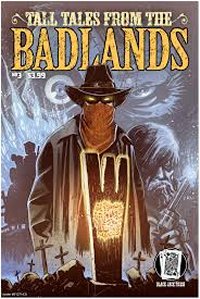 Tall Tales From the Badlands volume 3 (BlackJack Press)
Tall Tales From the Badlands volume 3 (BlackJack Press)
By Jeb D.
It’s common to regard the Western as the American mythological equivalent of the tales of great deeds and derring-do that powered the gods-and-monsters legends of Greece and Scandinavia. Comics is one of the rare areas that finds creators regularly integrating other tropes into the classic setting, and Tall Tales From the Badlands is the third volume of an anthology series aimed at bringing a darker tone to the Western than the more common Joseph Campbell-style “hero’s journeys” that are more or less the lingua franca of the genre; while it might be easy to type them as “horror” stories, they’re closer to Poe or Saki than, say, Steve Niles or Joe Hill.
The series’ mastermind is Sean Fahey, who longtime CHUD readers may know as the founder of this very comic-book review column you’re currently reading, so feel free to bear that in mind as you read my consideration of his latest volume.
One virtue of Fahey’s choice of story style to anthologize is that, with one exception, they’re less dependent on the kinetic excitement of such Western tropes as the gun battle, Indian fight, or cattle stampede, which are the sort of thing that can trip up less-experienced comic artists. Instead, the writer-driven tone of the series allows the artists to focus on underscore and characterization, and for the most part they acquit themselves very well.
Fahey is the scripter for two very effective stories here; in another context, a comic story of ten pages might qualify as little more than a “vignette,” but “Apologies” and “Where the Heart Is” are fully-fleshed narratives, with exposition provided sparingly, but sufficiently. “Apologies” is a grim story of a frontier family faced with death by starvation in the freezing desolate hills of Colorado. “Where the Heart Is” employs a similar Centennial State setting, but with a wildly different perspective and a neat twist.
As a series, Tall Tales of the Badlands stands out from its small-press brethren for the strength and consistency of its artwork; this may have something to do with the “classic” appeal of the American West as subject matter. John Fortune’s work on “Apologies” is highly polished and professional, with a good cinematic eye. Its only slight failing might be a tendency to undercut the darkness of the subject matter with some Eric Powell-style winking (the family children could have come straight out of an issue of The Goon). “Where the Heart Is” is a more static affair, but Ruben Rojas’ eye for period details nicely sets the scene for Fahey’s neatly executed ending.
“The Judgment of the People” is a story with another CHUD connection (writer Mark Wheaton was once well-known to CHUD readers as Smilin Jack Ruby), with art from Jerry Decaire. Its macabre story of the ultimate “triumph” of justice will sneak up on you, and Decaire gives it appropriately somber texture.
“Rustlers,” from writer Robert Napton and artist Franco Cespedes is the only story here that trades in familiar Western action tropes, and Cespedes acquits himself well with his depiction of a train robbery that leads, once more, to an unexpected, grim form of “frontier justice.”
Matt Dembicki’s “All Mine,” with art by Ezequiel Rosingana, opens with a riff on The Wild Bunch, and Rosingana delivers appropriately bleak and doom-laden work, his imaginative paneling driving the simple act of stepping on an insect to its bleak conclusion.
There also some “pinups” from Mauro Refschneider, Crash Landen (ho ho), and Adrian Bago Gonzalez. These are fairly typical “bonuses” in trade editions these days, though I’m not sure that anyone is pinning them up anywhere these days (maybe if it was Batman or someone); still, they’re well-executed, even if they really don’t add much in the way of value.
Tall Tales From the Badlands is a series that can give readers a new perspective on the storytelling possibilities inherent in our great American mythos, and while I’d feel comfortable recommending it on its own terms, as indicated above, it is the work of a longtime colleague. But if any potential purchaser fears that I’m letting that relationship cloud my judgment, Fahey offers readers a money-back guarantee for the print edition; you can find details here and order the book at these sites:
And the BlackJack Press Facebook page, which has preview images
With or without that moneyback guarantee, I can recommend Tall Tales From the Badlands to readers looking for a new twist on a familiar genre.
Rating: 




Out of a Possible 5 Stars
NEW AVENGERS (Marvel $3.99)
By Cat Taylor
One of the many quirks about big comic book universes like Marvel is that unless it’s a big crossover event, it’s not unusual for an epic-scale disaster to occur in one title and for nobody in any of the other books to even acknowledge it. By virtue of Jonathan Hickman writing both of the main Avengers books, he is able to have both teams focus on the same epic problems, but in different ways. For several issues now, the looming disaster that both Avengers teams face is as epic as it gets – the destruction of the entire universe as the result of a collision with a parallel alternate universe.
The “New Avengers” team in this book isn’t really an official Avengers team, but rather the Marvel Comics “Illuminati.” As the secret society that has been manipulating events in the Marvel Universe for years of comic book time, they’ve been putting their super-genius intellects to use by trying to find a way out of the impending destruction of everything. I know it’s hard to believe that a comic book about eggheads trying to solve the world’s problems in a lab would be exciting, but in my opinion the New Avengers comics have been better than the flagship Avengers books lately. Granted, there isn’t a ton of action in New Avengers in this issue, but it seems to be building up to something big. With the latest threat being the destruction of our entire universe and possibly more, most of the Illuminati/”New Avengers” watch a parallel Earth deal with the problem of their own universe facing the same imminent destruction that the primary Marvel universe is facing. With parallel universe storylines, it’s always interesting to see where and how things took a different path from the primary universe. In this alternate version we witness an Illuminati with some different members, including a few villains, and we learn briefly about human/mutant relations on their Earth.
While this is going on, the Dr. Strange of our own Marvel 616 Universe is trying to find his own mystical solution to saving the universe. Dr. Strange’s attempt at a solution involves him crossing over to a dimension called the Lost Lands. I’m not sure why they decided to call the dimension the “Lost Lands” because it’s pretty clearly one of the Marvel versions of Hell, and it’s not like Marvel has ever been squeamish about calling a Hell a Hell, but here it’s called the Lost Lands. So, that’s that. I don’t like to include spoilers in my reviews but I’m guessing I don’t have to for most people to figure out what Strange is planning to do in the “Lost Lands” to stop the destruction of our universe. However, the situation here left me with a few questions about the logistics of this “deal with the devil”.
With stories like this, Marvel shows greater awareness of their real audience than they have in the past. No matter what they do in an attempt to court younger readers, adults who have been reading comic books since they were children are their primary audience. Hickman’s current storylines are complex and “smart” enough for adult readers not to feel terribly insulted. Maybe that’s the intent, or maybe he assumes that younger readers are smarter than most people think.
Another way Marvel comics have evolved over the years is in the artwork. The days of the established “house style” in which artists were not supposed to stray too far from a formula that was epitomized in the work of John Byrne or John Buscema are practically gone. If individual styles and experimentation aren’t encouraged, they are at least accepted. It typically requires a certain level of competence to even be allowed to draw for a company as big as Marvel. So, I rarely question the talent of their artists. However, it does bother me if an artist’s style doesn’t fit the tone of the story. That’s not a problem with the artist in this issue. Simone Bianchi has a dark, angular style that feels appropriate for a story about the impending destruction of the entire universe.
New Avengers has been a slow burn since Hickman took over. Like a lot of multi-part comic stories nowadays, it feels like each issue is written with the intent of a trade paperback collection in mind. So, it’s a lot rarer to get the feeling of a complete chapter, much less a complete story, in a single issue. With that being said, it feels like Hickman is taking us through a journey that will be rewarding once the final chapter has been written.
Rating: 




Out of a Possible 5 Stars